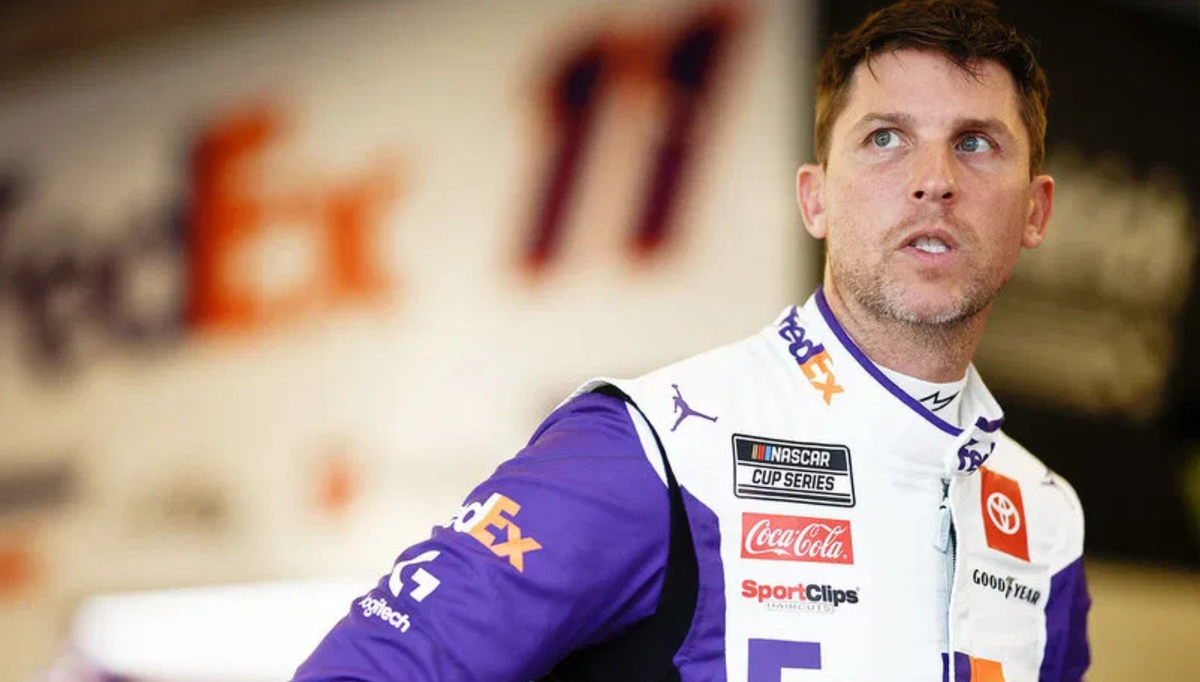

NASCAR’s 2026 Cup Series schedule is stirring up debate with reports that the All-Star Race might shift to Dover Motor Speedway, a track that’s held a single points-paying event each year since 2021. Denny Hamlin weighed in on this buzz, sharing his take on what the change could mean for the sport’s exhibition showcase, especially with the event’s $1 million prize purse at stake.
Watch What’s Trending Now!
This kind of venue swap isn’t new; back in 2020, the All-Star Race moved from Charlotte Motor Speedway to Bristol Motor Speedway amid COVID restrictions, marking the first time it left Charlotte in over three decades and drawing a record TV audience. Dale Earnhardt Jr. chimed in on the Dover talk with a quick reaction: “Jeff buried the (lede).” But Hamlin’s perspective digs deeper into why this rumor hits a nerve.
ADVERTISEMENT
Denny Hamlin questions Dover’s All-Star fit
Denny Hamlin pulled no punches on Actions Detrimental, protesting the idea of the All-Star Race heading to Dover if it means stripping the track of its points-paying status. He sees it as a step backward for a venue with solid fan support, especially given Dover’s history of drawing crowds even in tough conditions. This rumor surfaces now as NASCAR eyes the 2026 schedule release next week, aiming to slot a points race at North Wilkesboro Speedway, which hasn’t hosted one since 1996, by swapping the All-Star event over. Sources close to the talks confirm the consideration stems from Speedway Motorsports owning both tracks, making the exchange logistically smooth to revive North Wilkesboro’s points relevance after its $40 million modernization funded partly by federal aid.
To back his point, Hamlin said, “Surely they can’t be talking about replacing Dover’s point race, right? … We had such a great fan turnout when it was 120 degrees. It was like being on the sun.” This nods to Dover’s July 20, 2025, race, where fans packed the stands despite sweltering heat, as noted in attendance reports from Speedway Motorsports. The track, a one-mile concrete oval since 1969, lost its second annual race in 2021 due to schedule streamlining, dropping from two events yearly since 1971. Hamlin’s concern echoes the 1996 fallout at North Wilkesboro, where outdated facilities led to its removal from the Cup calendar, forcing a long hiatus until its 2023 All-Star revival sparked hopes for a full return, now potentially at Dover’s expense.
He doubled down with, “I just hope there’s no way they can be going from two races to none, no point races at Dover. The fan turnout’s been good there. I don’t know why you would do that.” Data from NASCAR’s own records show Dover’s consistent draw, with sellouts in recent springs before the shift to one race.
ADVERTISEMENT
Hamlin ties this to the All-Star’s short-run format clashing with Dover’s need for 30-40 laps to rubber in for passing, a trait verified in race logs from the 2025 Wurth 400, where lead changes ramped up mid-run. Without lights, banned near Dover Air Force Base, the event might run midday, limiting excitement, much like early complaints during Texas Motor Speedway’s 2021-2022 All-Star stints that prompted the move to North Wilkesboro. “This is not the best choice. Dover is just not an all-star type of racetrack,” he concluded.
Hamlin’s views on track choices tie into bigger talks about car performance. Shifting gears, he recently opened up about how the Next Gen setup is leveling the playing field in unexpected ways.
ADVERTISEMENT
Hamlin calls out Next-Gen speed parity
Denny Hamlin got real on his podcast about the Next Gen car’s evolution, pointing out how teams have caught up to create tighter competition. Introduced in 2022 to boost parity and safety, the car has narrowed speed gaps across the field, making every position harder to gain. Hamlin explained that this shift stems from limited development, turning early advantages into a pack where overtakes demand precise edges.
He laid it out clearly. “The field is just now running the same speed, and at a track where you have to have three to three and a half tenths of speed to overtake the car in front of you, that means that the first-place fastest car is going to struggle to pass the 25th if he just gets put behind him. That is the fundamental part that is going to be tough for us to overcome.” Lap time data from NASCAR’s 2025 Iowa Speedway event backs this, with the leader lapping slower cars only after extended runs, as differences shrank from seven-tenths early in the Gen-7 era to 0.7–1.0 seconds in 2022 to 0.3–0.4 seconds in 2025.
ADVERTISEMENT
This parity, praised for closer finishes in intermediates per NASCAR’s competition reviews, highlights dirty air issues on shorts, where Hamlin suggests downforce tweaks could help, similar to Xfinity Series adjustments that eased manipulation of cars ahead. Goodyear’s high-wear tire at Richmond in 2025, following Iowa’s low falloff, showed promise in mixing up strategies, aligning with Hamlin’s call for tweaks to keep racing dynamic. Fans relate to this frustration from watching leaders stuck mid-pack, but it underscores the car’s goal of evening odds for underdogs, as seen in surprise winners like Austin Cindric at Gateway in 2024.
ADVERTISEMENT
ADVERTISEMENT
ADVERTISEMENT

